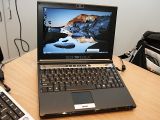AMD's 780G platform has been one of the most important announcements made at this year's CeBIT exhibition. So, in order to find out more about this particular product, as well as AMD's plans for the future, we've carried out a very exciting interview with Ian McNaughton, senior product manager at AMD, which provided us with some very important pieces of information regarding the company's plans.
Softpedia: How do you think that the latest innovation you've announced, the 780G chipset, will influence the market of HD cards and solutions? Do you think that it will bring a whole shift in the market?
Ian McNaughton, AMD: I think it will have an unprecedented influence on the market. We think that the new RS780 is the best chipset the world has ever seen, as it offers a level of performance that has never been achieved before in the case of a motherboard GPU, it has a new set of instructions, it has connectivity that enables new displays like never before on the market, it offers a DX10 GPU core, it is by far the best experience available.
When you have the opportunity to launch a product like that, it's rare, in a sense that it offer significant performance. And it's funny because 2 days ago we found online a motherboard for sale with RS780 included for just 69 dollars. So you're looking at a price point which offers performance capabilities, key quality, Blu-ray playback with a single-battery charge on the new Puma platform. This is not just a desktop platform, it's a PC platform.
Softpedia: Since you've mentioned the Puma platform, can you tell us just how soon do you expect products that incorporate this platform to arrive in stores?
Ian McNaughton, AMD: So, we can control what we ship towards the system manufacturers and integrators, but it's up to them at this point in time. And I don't want to speak on their behalf, but we believe, from talking to them, that Q2 will be the moment when the production will start for the products incorporating the Puma platform, and also the time frame when the first products incorporating this platform will arrive in stores.
Softpedia: The second most important announcement you've made at this year's CeBIT is related to the 45-nm Phenom processor. So, what do you think that this new CPU is going to do for AMD?
Ian McNaughton, AMD: This new Phenom will increase the performance in a cooler, quieter environment, because the processor itself will be cooler and quieter. We built in new cooling pipe features into the actual silicon, but it's the market infrastructure what's really important here. When we talk about power saving, we're talking about the actual envelopes of PC's power. You're looking to HD PC's, notebooks, and it's actually a very wide range of power limitations, as we can be dealing with either a desktop chassis or a notebook chassis.
We're going to deliver more performance, more cache, a better experience for our consumers, we'll be delivering it on time to our clients, and as you've seen, it's real, it's there, and the products will probably arrive towards the second half of 2008.
Softpedia: When do you think that quad-core processors will become a more affordable, mainstream solution?
Ian McNaughton, AMD: One of the things that we'll be doing in the near future is launching our triple-core products. Of course, we could talk about quad-core, but for me to better answer your question triple-core is a better subject. So we have Sempron, single-core, for the emerging markets, we have dual core and since we're able to deliver a very high level of scalability, we'll also have triple-cores.
And what does that mean for the consumer? Well, we've got an extra-core designed to take over what's clogging the other two cores. This is designed for those people who don't want to invest in a quad-core, because it's a bit too expensive or they simply don't trust the technology yet. For this category of consumers, it's an interim step. When we're talking about the mainstream market, three cores is better than two cores, and four cores is better than three cores in that respect, and what we're doing is basically plugging a hole and offering a solution for mainstream that won't be at an quad-core price. It will be an exceptional value, because it will probably be easier for people to move from dual-core to triple core in case they don't want to go to quad. They'll go to three-core and they'll have a higher level of performance around the same price range.
Softpedia: You'll already shipping the triple-core to OEM's, so can you tell us when the products equipped with such solutions will arrive in stores?
Ian McNaughton, AMD: Well, we're probably dealing with a Q2 time-frame.
Softpedia: Will your future CPUs provide support for DDR3?
Ian McNaughton, AMD: We'll be offering support for DDR3 in all our 45-nm products. But let's be clear about one thing. We, obviously, as a CPU company, have a very vivid interest in everything related to the platform, like the socket design, the cooler design, the memory, everything like that. We make sure to work with all the eco-system of the PC.
At the same time, we're very customer-centric. We have a very close relationship with the OEMs, so we go to them and ask them "What is your launch roadmap?" And they say "Here's where we are. We're enforcing the DDR2, but not the DDR3". They said that "Somewhere towards the end of 2008, beginning of 2009, that's where we wanna be". So we've also adjusted our roadmaps, and that's what we're going to deliver.
Basically, that's the most important point. We're customer-centric, as opposed to our competitors, who have a very different approach. We'll be moving to DDR3 when it makes sense for our customers, especially since the performance increase over the DDR2 is negligible, the prices of DDR3 modules are still rather high and the module availability is sparse.
So, DDR2 is still king, we're still supporting DDR2, and we'll be moving on towards DDR3 when the market requires it. We don't have the Front Side Bus problem, we don't need to increase the speed on the FSB to match that of the memory module, that's our competitors. This is a strong point of our architecture, and this has allowed us to offer exceptional performance in an eloquent design.
Softpedia: We've heard some rumors regarding the possibility of outsourcing the supply of CPUs. How can you comment on that?
Ian McNaughton, AMD: We're very dedicated to our factory in Dresden, Germany, as well as our other facilities, which represent key elements in the success of AMD.
Softpedia: The Barcelona processors have been known to exhibit some problems in the past. What have you done to mitigate this issue?
Ian McNaughton, AMD: You're probably referring to the infamous "TLB" issue. On the consumer side, nobody on the planet has been able to recreate the TLB problem on a consumer application suite. That's just something that the press took and, unfortunately, it snowballed, and there weren't enough of us to go around the world and explain that this is not a real issue of concern.
As you know, there's already a BIOS workaround for this issue, the OEM's are very accepting of this problem, so, this time around, I guess it was just a problem of communication. Moreover, we will be announcing very soon the B3 revision, which will solve this problem for good and this will be the end of our TLB experience.
Softpedia: When will AMD roll out a fully-integrated CPU-GPU solution?
Ian McNaughton, AMD: So, Fusion. You're talking about Fusion. The corporate timelines of Fusion have been changed, we're talking about a 2009 kind of time - frame, as it's a pretty exciting technology, which will be the fruit of the labor of the acquisition of ATI. The launch of the RS780 was the base of the platform innovation, and you'll see that the future will bring the on-dye innovation of the same technology. So I think that 2009 will the disruptively exciting from this point of view.
Softpedia: How does AMD plans to further increase its market share ?
Ian McNaughton, AMD: We have grand plans to take a lot away from our competitors, and we're going to do that by offering the ultimate video experience. It's all about the experience in your PC. The days in which having the fastest chip or the fastest GPU are over. It's all about the experience one can enjoy on their PC.
When you look at what we're offering to the consumer, we're delivering a better experience. And the RS780 delivers a discrete-level experience directly on your motherboard. It's capable of delivering superior capabilities to those of the competition in terms of graphics. And that's what's going to change the game. It's no longer about "I have the world's fastest processor". Because a processor is not the only thing that matters. You can have the world's fastest processor and you pair that with a really bad chipset, and it basically cripples that processing capability. This is why we've purchased ATI and we're integrating all of their technologies into our products, thus delivering platform-level innovations. Because that's exactly what AMD is about, AMD is all about platform innovation.
Interview carried out at CeBIT 2008 Hanover, Germany.

 14 DAY TRIAL //
14 DAY TRIAL // 


